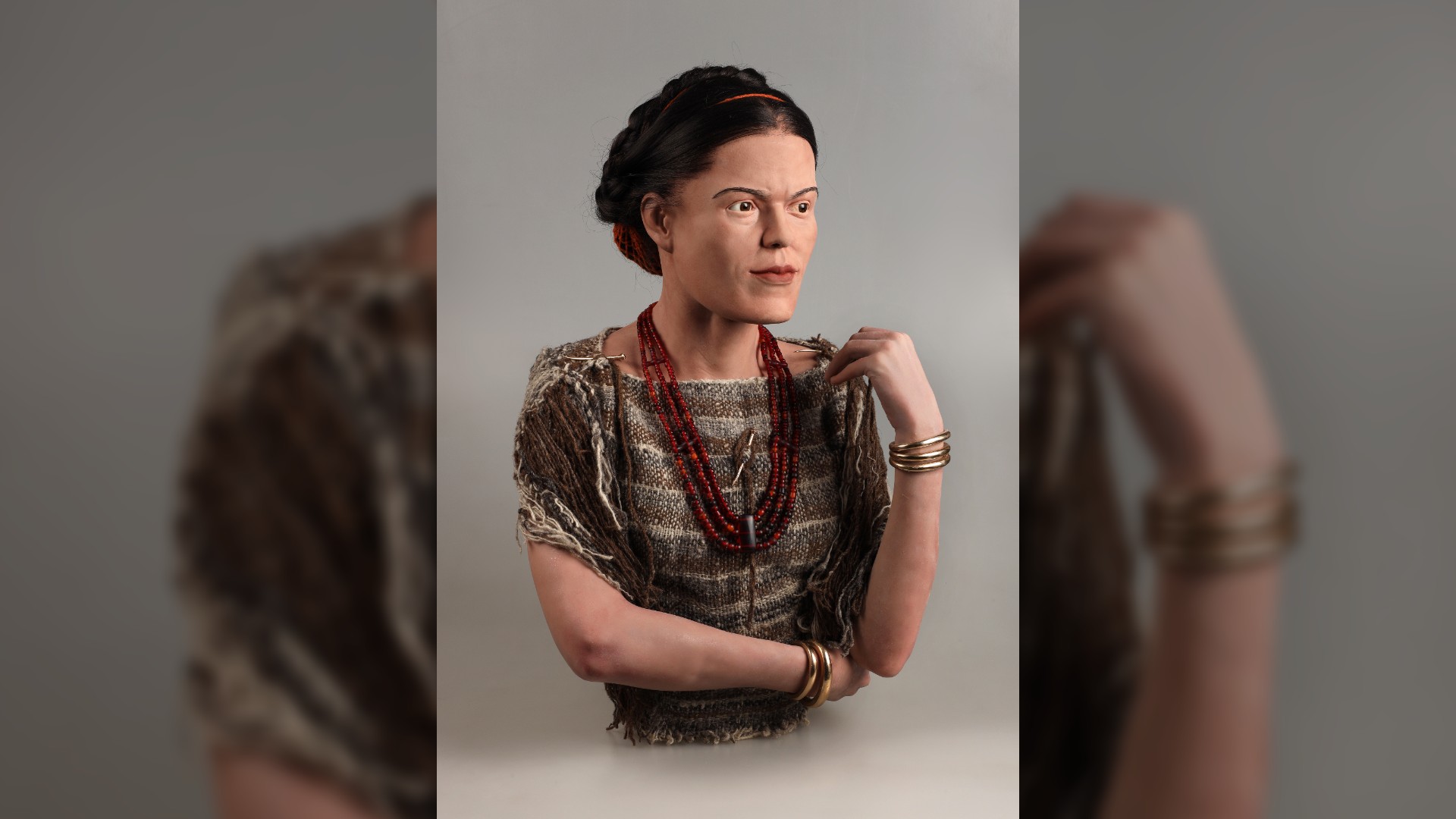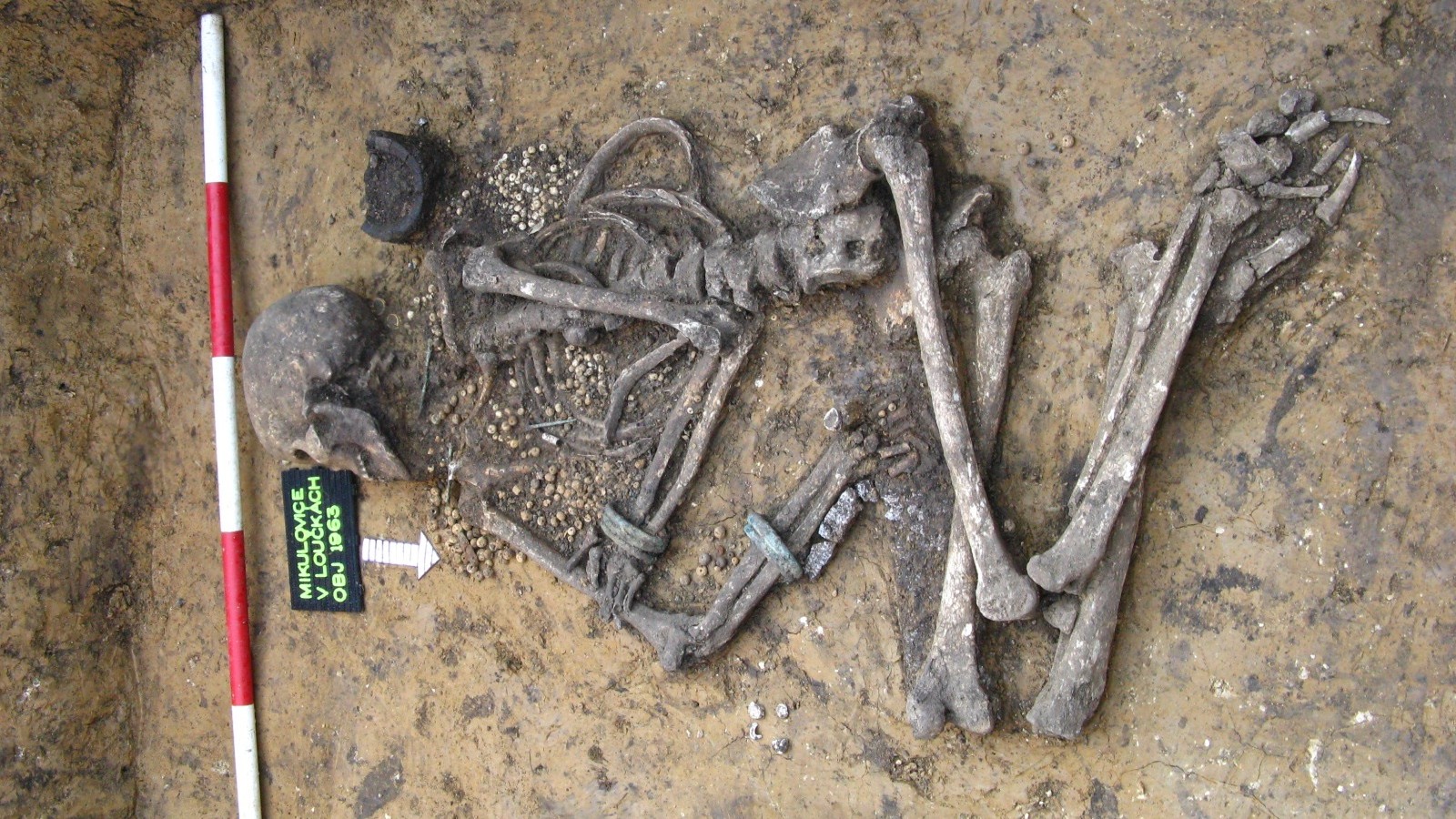Face of wealthy Bronze-Age Bohemian woman revealed in stunning reconstruction
The face of a woman who lived in Central Europe nearly 4,000 years ago has been reconstructed from her skull and remnants of her DNA.

Researchers have reconstructed the face of a petite, dark-haired woman who was among the richest residents of Bronze-Age Bohemia.
The woman was buried with five bronze bracelets, two gold earrings and a three-strand necklace of more than 400 amber beads. Also entombed with her were three bronze sewing needles. She was part of the Únětice culture, a group of peoples from early Bronze Age Central Europe known for their metal artifacts, including ax-heads, daggers, bracelets and twisted-metal necklaces called torcs.
While it's unclear who the woman was, she was very wealthy, said archaeologist Michal Ernée of the Institute of Archeology of the Academy of Sciences of the Czech Republic.
"It's maybe the richest female grave from the whole Únětice cultural region," Ernée told Live Science.
Related: Facial reconstruction shows powerful Bronze Age woman's serene expression and huge earrings
Wealth and trade

The woman lived between 1880 B.C. and 1750 B.C., according to radiocarbon dating of the cemetery where her bones were found. The graveyard is near the village of Mikulovice in the northern Czech Republic, in the northern Czech Republic. This area and the surrounding regions are known as Bohemia because they comprised a kingdom of that name prior to World War I. The 27 graves in the cemetery proved to be a remarkable treasure trove of artifacts, including about 900 amber objects.
"We have amber in 40% of all female graves," Ernée said. There is more amber in this single cemetery than in all of the Únětic graves in Germany, he said.
Get the world’s most fascinating discoveries delivered straight to your inbox.
"We have two neighboring regions of one archaeological culture, but the social system[s] were probably not the same," he said.
This amber likely hailed from the Baltic, indicating that the Únětice people were part of a far-reaching trade network in Europe at the time. The bronze objects made by contemporary Europeans also show the sophistication of Bronze Age trade, Ernée added: Bronze objects are found across the continent, but the raw materials for bronze, tin and copper came from only a few regions.
A woman of means

Of the skeletal remains found in the cemetery near Mikulovice, the amber-wearing woman had the best-preserved skull. It was a fortunate coincidence that the richest grave also had skeletal remains that could provide the basis for a reconstruction, Ernée said.
Also fortunate was that the bones were well preserved enough to still contain pieces of the woman's DNA. These genetic sequences enabled the researchers to discover that her eyes and hair were brown and her skin was fair. Anthropologist Eva Vaníčková of the Moravian Museum in Brno and sculptor Ondřej Bílek collaborated to make the torso-up model of the woman.
The woman's recreated clothing and accessories were based in science, as well. Ludmila Barčáková of the Institute of Archaeology of the Academy of Sciences made the amber necklace and gold earrings, metalworker Radek Lukůvka recreated the bronze bracelets and needles, and Kristýna Urbanová, an archaeologist specializing in textiles, fashioned the woman's clothing.
Ancient DNA was salvageable from other bones in the cemetery, so researchers are now working to find out how the individuals buried there were related, Ernée said. The cemetery could also provide new clues into regional differences in early Bronze Age Central Europe. In neighboring regions of Bohemia, Ernée said, the rich graves that are found all belong to men. It's unclear if women had a different status in the region near modern-day Mikulovice, he said. It's possible that the women did individually control more wealth than women in nearby regions, but it's also possible that they were buried with riches to show off the wealth of their male relatives.
Editor's note: This article has been updated to indicate that in neighboring regions of Bohemia the wealthiest graves belonged to men.
Originally published on Live Science.

Stephanie Pappas is a contributing writer for Live Science, covering topics ranging from geoscience to archaeology to the human brain and behavior. She was previously a senior writer for Live Science but is now a freelancer based in Denver, Colorado, and regularly contributes to Scientific American and The Monitor, the monthly magazine of the American Psychological Association. Stephanie received a bachelor's degree in psychology from the University of South Carolina and a graduate certificate in science communication from the University of California, Santa Cruz.


